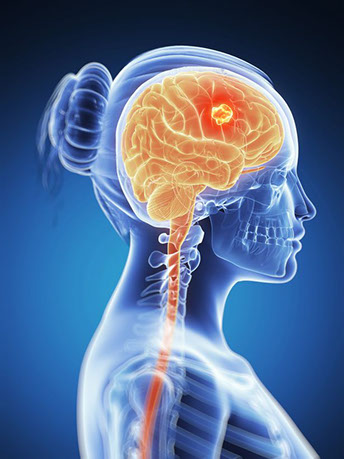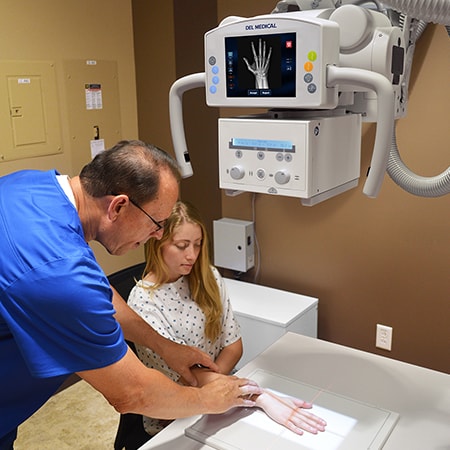
What is a Brain Stroke?
A Brain tumor is a collection, or mass, of abnormal cells in your brain. Your skull, which encloses your brain, is very rigid. Any growth inside such a restricted space can cause problems. Brain tumors can be cancerous (malignant) or non-cancerous (benign). When benign or malignant tumors grow, they can cause the pressure inside your skull to increase. This can cause brain damage, and it can be life-threatening.
Brain tumors are categorized as primary or secondary. A primary brain tumor originates in your brain. Many primary brain tumors are benign. A secondary brain tumor, also known as a metastatic brain tumor, occurs when cancer cells spread to your brain from another organ, such as your lung or breast.
Types of Brain Strokes
Primary Brain Strokes
Primary brain tumors originate in your brain. They can develop from your:
Brain cells
The membranes that enclose your brain, which is called meninges
Nerve cells
Glands
Primary tumors can be benign or cancerous. In adults, the most common types of brain tumors are gliomas and meningiomas.
Gliomas
Gliomas are tumors that develop from glial cells. These cells:
- Support the structure of your central nervous system
- Provide nutrition to your central nervous system
- Clean cellular waste
- Break down dead neurons
Gliomas develop from a variety of glial cells.

The types of tumors that begin in glial cells are:
- Astrocytic tumors such as astrocytomas, which originate in the cerebrum and are often benign.
- Oligodendroglial tumors, which are often found in the frontal temporal lobes. Glioblastomas, which originate from the supportive brain tissue and are the most aggressive type.
- Meningiomas, which originate in the meninges.
- Schwannomas, which originate in cells that produce the protective cover of your nerves (myelin sheath) called Schwann cells.
- Most meningiomas and schwannomas occur in people between the ages of 40 and 70.
- Meningiomas are more common in women than in men.
- Schwannomas occur equally in both men and women.
These tumors are usually benign, but they can cause complications because of their size and location. Cancerous meningiomas and schwannomas can be very aggressive.
Other Primary Brain Tumors
Other primary brain tumors include:
- Pituitary tumors, which are usually benign
- Pineal gland tumors, which can be benign or malignant
- Ependymomas, which are usually benign
- Craniopharyngiomas, which occur mostly in children and are benign but can have clinical symptoms like changes in vision and premature puberty
- Primary brain lymphomas, which are malignant
- Primary central nervous system (CNS) lymphomas, which are malignant
- Primary germ cell tumors of the brain, which can be benign or malignant
Secondary Brain Strokes
Secondary brain tumors make up the majority of brain cancers. They start in one part of the body and spread, or metastasize, to the brain. The following can metastasize to the brain:
- Lung Cancer
- Breast Cancer
- Kidney Cancer
- Skin Cancer
Secondary brain tumors are always malignant. Benign tumors don’t spread from one part of your body to another.
What Are the Symptoms of a Brain Strokes?
Symptoms of a brain tumor can be general or specific. A general symptom is caused by the pressure of the tumor on the brain or spinal cord. Specific symptoms are caused when a specific part of the brain is not working well because of the tumor. For many people with a brain tumor, they were diagnosed when they went to the doctor after experiencing a problem, such as a headache or other changes.
Symptoms of brain tumors depend on the location and size of the tumor. Tumors cause direct damage by invading brain tissue and causing brain pressure to increase. You’ll have noticeable symptoms when a growing tumor is putting pressure on your brain tissue.
General symptoms include:
Headaches are a common symptom of a brain tumor. You may experience headaches that:
- Are worse in the morning when waking up
- Occur while you’re sleeping
- Are made worse by coughing, sneezing, or exercise
You may also experience:
vomiting
- Blurred vision or double vision
- Confusion
- Seizures (especially in adults)
- A Weakness of a limb or part of the face
- A change in mental functioning
Other common symptoms include: - Clumsiness
- Memory loss
- Confusion
- Difficulty writing or reading
- Changes in the ability to hear, taste, or smell
- Decreased alertness, which may include drowsiness and loss of consciousness
- Difficulty swallowing
- Dizziness or vertigo
- Eye problems, such as drooping eyelids and unequal pupils
- Uncontrollable movements
- Hand tremors
- Loss of balance
- Loss of bladder or bowel control
- Numbness or tingling on one side of the body
- Trouble speaking or understanding what others are saying
- Changes in mood, personality, emotions, and behavior
- Difficulty walking
- Muscle weakness in the face, arm, or leg
How Are Brain Tumors Diagnosed?
Diagnosis of a brain tumor begins with a physical exam and a look at your medical history.
The physical exam includes a very detailed neurological examination. Our doctor will conduct a test to see if your cranial nerves are intact. These are the nerves that originate in your brain.
Our doctor will look inside your eyes with an ophthalmoscope, which is an instrument that shines a light through your pupils and onto your retinas. This allows Our doctor to check how your pupils react to light. It also allows Our doctor to look directly into your eyes to see if there’s any swelling of the optic nerve. When pressure increases inside the skull, changes in the optic nerve can occur.
The doctor may also evaluate your:
- Muscle strength
- Coordination
- Memory
- Ability to do mathematical calculations
Our doctor may order more tests after they finish the physical exam. These could include:
CT Scan of the Head
CT scans are ways for Our doctor get a more detailed scan of your body than they could with an X-ray machine. This can be done with or without contrast.
Contrast is achieved in a CT scan of the head by using a special dye that helps doctors see some structures, like blood vessels, more clearly. You often have to fast before a CT scan that’s using contrast.
MRI of the Head
If you have an MRI of your head, a special dye can be used to help Our doctor detect tumors. An MRI is different from a CT scan because it doesn’t use radiation
Angiography
This study uses a dye that’s injected into your artery, usually in the groin area. The dye travels to the arteries in your brain. It allows Our doctor to see what the blood supply of the tumors looks like. This information is useful at the time of treatment.
Brain Scan
A Brain scan uses a harmless radioactive dye that’s injected into a vein. When the dye goes through the veins in the tumor, an image is taken.
Skull X-Rays
Brain tumors can cause breaks or fractures in the bones of the skull, and specific X-rays can show if this has occurred. These X-rays can also pick up calcium deposits, which are sometimes contained within a tumor. Calcium deposits may be in your bloodstream if your cancer has moved to your bones.
Biopsy
A Small piece of the tumor is obtained during a biopsy. A specialist called a neuropathologist will examine it. The biopsy will identify if the tumor cells are benign or malignant. It will also determine whether cancer originated in your brain or another part of your body.



